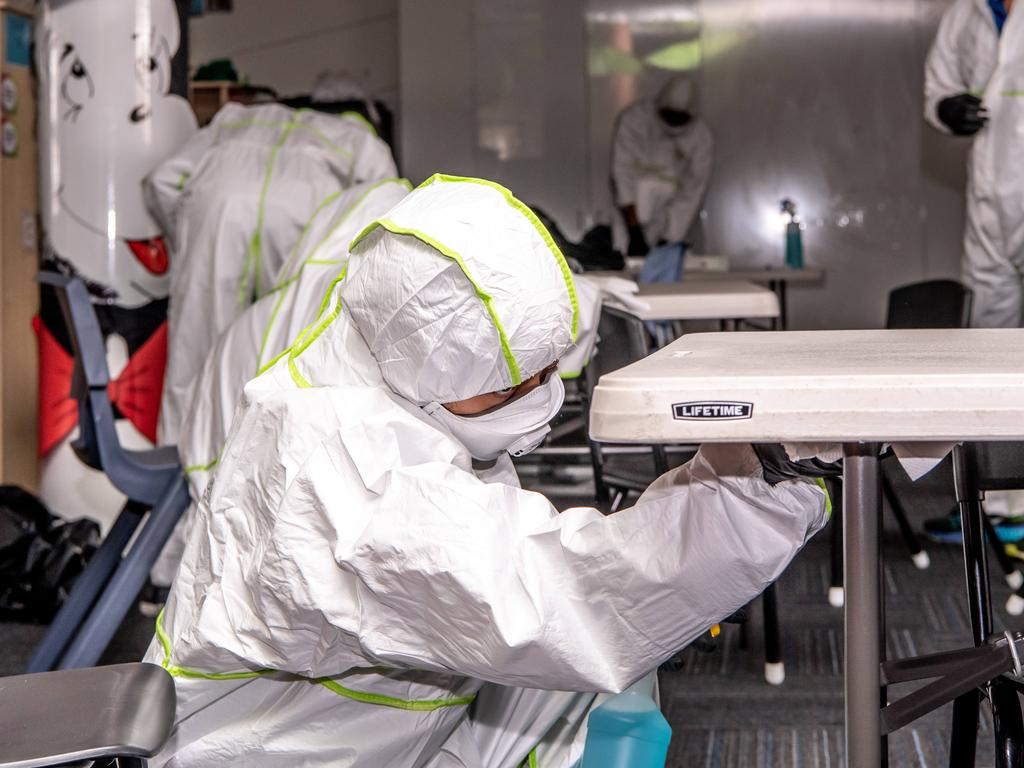The coronavirus can survive on surfaces for up to three days – here’s how to clean it
New research shows the coronavirus can live on surfaces for up to three days. Here’s how you can give your home a proper scrubdown.
Research has shown the coronavirus can live on some surfaces for as long as two to three days – but once its there, how do you clean it off?
Well it all depends on where the germs have been left, whether it has been smeared on your kitchen counter or living in fibres such as your clothes and handbags.
A study released last week found the virus could survive on hard surfaces such as plastic and stainless steel for up to 72 hours and on cardboard for up to 24 hours.
“This virus has the capability for remaining viable for days,” said study author James Lloyd-Smith, an assistant professor of ecology and evolutionary biology at the University of California, Los Angeles.
Despite knowing some surfaces are less hospitable to the COVID-19 virus than others, advice on how to clean it off is the same.
The best way to prevent the virus living on your surfaces is to use ammonia or alcohol-based cleaning products, NPR advises.
RELATED: Follow the latest coronavirus updates
RELATED: Ways to keep your family safe from coronavirus
RELATED: Take our coronavirus poll

Take a clean cloth or a wipe containing the bug-killing chemical and wipe down your surfaces thoroughly.
If you use a reusable cloth, make sure you put it straight in the wash and don’t leave it lying on your kitchen counter.
Considering wipes and cleaning products can be hard to locate at the moment, you can also rely on trusty soap and water to do the trick.
“The good thing about COVID-19 is that it does not require any unique cleaning chemicals to disinfect hands and surfaces,” Andrew Janowski, an infectious disease expert at Washington University School of Medicine and St. Louis Children’s Hospital told the publication.
The cleaning advice comes after research found coronavirus can live on some surfaces for as long as two to three days, tests have shown.
The research by US Government and other scientists were posted last week on a site where researchers can quickly share their work before publication.
“We’re not by any way saying there is aerosolised transmission of the virus,” National Institute of Allergy and Infectious Diseases study leader Neeltje van Doremalen told AP.
But she said the work showed the virus was able to stay viable for long periods in those conditions, so it was theoretically possible.
The tests found the virus could be detected up to three hours later in the air, up to four hours on copper, up to 24 hours on cardboard and up to two to three days on plastic and stainless steel.
Researchers say the results were similar to ones achieved with the 2003 SARS outbreak so differences in the durability of the viruses don’t explain why the coronavirus has spread so widely.
The tests were done at the National Institutes of Health’s Rocky Mountain Lab in Hamilton, Montana, by scientists from the NIH, Princeton University and the University of California, Los Angeles, with funding from the US government and the National Science Foundation.
=
Researchers are looking into the best way to kill the virus but van Doremalen said it was likely that cleaning surfaces with solutions containing diluted bleach would get rid of it.
Julie Fischer, a microbiology professor at Georgetown University, said people needed to keep following good hygiene practices.
“What we need to be doing is washing our hands, being aware that people who are infected may be contaminating surfaces,” and keeping hands away from the face, she told AP.
On Wednesday (local time) the World Health Organisation declared the coronavirus outbreak was a pandemic. More than 121,000 people in 118 countries have been infected and over 4300 people have died of the virus.
“The WHO has been assessing this outbreak around the clock and we are deeply concerned both by the alarming levels of spread and severity, and by the alarming levels of inaction,” WHO chief Tedros Adhanom Ghebreyesus said.
“We have therefore made the assessment that COVID-19 can be characterised as a pandemic.”




